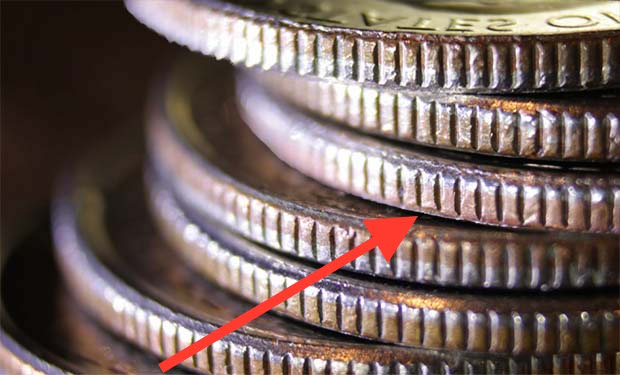Did you notice the coin ridges on the edges of your picket change? Ever wonder why government treasuries spends so much money on creating those tiny little ridges? Wouldn’t it be easier and cheaper to build a smooth one? Of course, the Treasury might save some money to make the edges smooth. However, the U.S. Treasury has a very old and very practical reason for putting ridges on coins.

Back in the Beginning, coin ridges did not exist
Before the American Revolution, it was very hard to find any coins that had reeded edges.
The story of ridges on coins goes back to 1792 when the Coinage Act declared that gold eagles, half eagles and quarter eagles ($10, $5 and $2.50 coins respectively) would be made of their face value in gold. While that may come as a surprise to many, U.S. currency was in fact once made of real gold and silver.
The U.S. dollar, half-dollar, quarter dollar, dime and half-dime coins were to be manufactured of their value in silver. Also, the cent and half-cent coins were to be made of copper. The edges of all of these coins were smooth.
READ MORE: You Are Stranded On A Desert Island. You Can Choose 4 of the-Following…
However, creative individuals soon realized that they could make a reliable profit from these coins if they filed down shaved down the sides of gold and silver coins and sell the shavings as precious metal. People called this shaving coins and clipping coins. Then, they would trade their shaved-down coins at their face value. Thus, they would earn a profit on the value of the precious metal. A person could only collect a small amount of metal from each coin, but it added up over time.
However, this strategy only worked if few people were doing it. Since people earned money from clipping coins, more people started doing it. Soon, everyone knew that coins were not their true weight in gold, silver, and copper because so many coins had their edges shaved.
In response, the U.S. Mint started to put the ridges, also called “reeding”, on the sides of valuable coins as a security feature. A person cannot shave the edges of a ridged coin without the tampering being immediately visible. Any one would notice changes on sight.
The Unexpected Benefit of Coin Ridges
The ridges produce another benefit too. The ridges also make the coins distinguishable by touch, which helps visually-impaired citizens tell similar-sized coins (like pennies and dimes) apart. Pennies and dimes may be small coins today. But way back in the Depression era, the difference used to be very important.
Conclusion: Coins Have Ridges Because It’s Tradition
Of course today, the U.S. mint does not make U.S. coins from precious metals like silver and gold. So, people are not shaving cheap metal from the coins. Still, U.S. half-dollars, quarters, and dimes still keep with the tradition of putting ridges on the edges of the coins.
Read something else:


